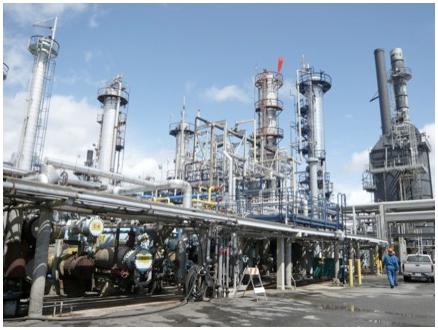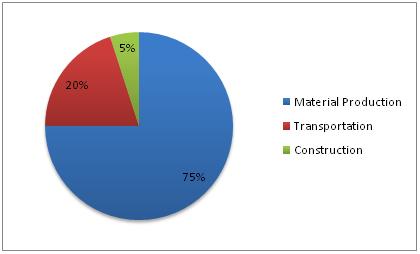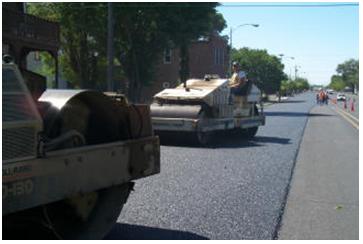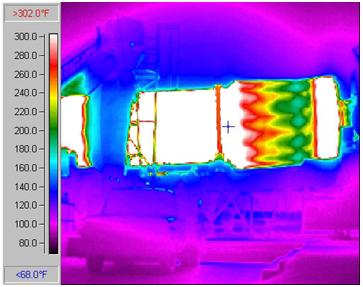When we think of energy use in our roadways, we tend to think about burning gasoline in our cars. With growing concerns about environmental health as well as rising fuel prices, automobile manufacturers are looking at ways to make driving more energy efficient. But what about the energy it takes to build the road itself? What aspects of road construction have the biggest energy demand, and how does the total demand of construction stack up to roadway use? In this edition of the RoadReady Newsletter, we’re going to explore the energy requirements of roadway construction.
Road Construction and Energy
Understanding the energy requirements for roadway construction requires looking at the big picture. As a whole, roadway construction only makes up a small part of the energy use of a roadway throughout its lifetime, the majority of which results from traffic on the roadway. A study of roadway projects across Europe estimated that on average, roadway traffic is about 18 times more energy intensive than construction.

Relative contribution of construction and traffic to total roadway energy use
However, the energy used during construction is still significant, and worth taking a look at. Apart from the energy and fuel used during the actual pavement placement, energy is required to produce and refine materials, transport materials and equipment, and eventually to dispose of the roadway. In road construction, most of the energy demand has little to do with pavers, or pavement placement.
Embodied Energy
When considering the total energy consumption of a construction process, it is important to understand the concept of embodied energy. For a given material or product, the embodied energy represents the total sum of energy inputs for each process in the production chain. This includes the extraction of raw materials, processing of these materials, transportation, disposal, and any other treatments that require energy. Embodied energy is measured by units of energy as a function of either material volume or density.
The energy required to extract, produce, and refine paving materials is a huge contributor to the energy required for road construction, whether they are constructed using asphalt or concrete. As a result, the embodied energy of each material tells us a lot about the total requirements of road construction. Let’s take a look at some of the major energy sinks for each of these materials.

Processes such as petroleum distillation contribute to the embodied energy of asphalt
Asphalt
Production of asphalt for road construction begins with the extraction and refinement of petroleum. Raw petroleum must be distilled to break it down into its individual components, some of which are used in asphalt pavements. To do this, petroleum must be subjected to intense heat and pressure. Once the asphalt binder has been separated, it must be heated continuously to prevent it from solidifying. As a result, even storing asphalt binder has an energy cost. Asphalt cement, however, is not the only component of paving asphalt. Aggregates must also be extracted, whether this is from virgin sources or recycled materials. These aggregates are then crushed and stockpiled until used to produce asphalt concrete. Aggregates are then dried and mixed with the asphalt cement, and can be transported to a construction site. Aggregate drying and asphalt mixing at the plant are the largest energy sinks in the asphalt production process. Estimates of the embodied energy of asphalt vary, but generally hover around a value of three megajoules for each kilogram of paveable asphalt produced. To put this into context, the power needed to make one kilogram (about 2 pounds) of asphalt could power a typical household for about an hour.
Concrete
The embodied energy of concrete is dominated by production of Portland cement. This is done by heating calcium carbonate, or limestone, to extremely high temperatures. This allows the release of a carbon dioxide molecule from the calcium carbonate forming calcium oxide, which is mixed with other materials to form clinker. This is then combined with gypsum to create cement. Other individual components of concrete production, such as mixing and processing, consume much less energy than cement production. Much like asphalt, the embodied energy of concrete includes the extraction, crushing, and stockpiling of aggregate. However, concrete production does not require aggregates to be dried prior to mixing. Estimates of embodied energy for concrete are typically around one megajoule per kilogram of concrete produced.
Total Energy Consumption
A number of studies have attempted to characterize the total energy inputs of a roadway paving project. Because every roadway project is different, and methodologies differ between researchers, there is no single correct value of a roadway’s energy cost. A meta-study at the University of Washington found that a reasonable estimate of total energy consumption is between two and four terajoules per lane-km of roadway paved. A lane-km is defined as a kilometer long segment of roadway that is a single lane in width (for example, a one kilometer stretch of a standard two lane road represents two lane-km). The lowest values noted in this study found values less than a single terajoule per lane-km, while the highest values exceeded seventeen terajoules per lane-km. Despite the significant process differences between asphalt and PCC road construction, both flexible and rigid pavement types have similar results for total energy consumption. The chart below shows a typical breakdown of energy use by process type, from the same collection of studies. These values are approximate, and can vary widely among different projects.

Typical energy consumption breakdown for a roadway construction project
To put these numbers in context, the energy needed to construct one lane of road one kilometer in length is the equivalent of burning 23,000 gallons of conventional gasoline. Assuming a gas mileage of 20 miles per gallon, this means that the total energy input to pave one kilometer (.6 mi) of a one lane road is equivalent to the gas needed to drive 750,000 cars across its length. In general, the energy costs of construction are eclipsed by vehicle use over the first two years of the roadway life. The Greenroads manual, a sustainability rating systems for road construction, estimates that the construction one lane-km of road uses about the same amount of energy as 20-40 average U.S. households over a one-year period.

Rehabilitating roadways uses less energy than building new ones
Research attention has also been focused on energy needs for roadway rehabilitation. For overlays of asphalt pavements, numbers range from about 100 to 300 megajoules for each square meter of pavement dependent on the thickness of the overlay, aggregate haul distance, and other variables such as the use of recycling. As an example, assuming a lane width of 3.6 meters (12 feet), this translates to a range of 0.4-1.2 terajoules per lane-kilometer. As a result, when comparing to the energy numbers we discussed earlier, we can see that roadway rehabilitation is approximately one fourth as energy intensive as new construction.
Room for Improvement
As industry looks to make road construction more energy efficient, a good first step is to explore the “big-ticket” items that drive energy costs for different types of pavement, such as cement production and asphalt mixing. For instance, because cement production is responsible for such a large percentage of total energy use for rigid pavements, technologies which can offset the cement content in concrete have the potential for significant energy savings. These include cementitious materials such as blast-furnace slag, natural cements, and hydrated lime, as well as natural pozzolans including fly ash and silica fume. In addition to replacing some of the cement in the mixture, pozzolans have other benefits including improved workability and resistance to sulfates.

Technologies such as warm-mix asphalt help reduce the energy requirements of the mixing process
In contrast, in asphalt production, some of the largest energy needs are the drying of aggregates and mixing in the asphalt plant. As a result, improved drying practices for aggregate can improve energy usage. In addition, use of warm-mix asphalt technologies allows asphalt to be mixed at a lower temperature. Warm-mix asphalt production uses a number of chemical or physical processes to increase the fluidity of asphalt at lower temperatures, allowing reduction of energy needs by as much as 20%.
Despite the energy requirements of roadway construction, automobile still dominates energy use on the roadway. However, the energy that goes into building and maintaining our roadways is not a trivial matter. Energy intensive material production and construction have heavy costs, both environmental and financial. Technologies like warm-mix asphalt and concrete additives are making roadway construction more energy efficient and will continue to in the coming years. While we focus on making our cars more efficient, we will continue to work on reducing the energy footprint of the roads we drive on.


Queries:
1. What’s the typical no of passing for a tandem road roller and pnematic roller for asphalt patching of pot holes.
2. What’s the curing period for freshly laid asphalt patching.
3. What’s the required compaction layer? is 7mm thick sufficient/
thanks,
dave
Giving consideration to the fact that enormous embodied energy is utilized in the production of HMA, it is needed that all out efforts be made to protect the existing pavement through effective maintenance. As such the costly and enegry consuming processes of reconstruction may be eliminated and the existing roads’ surfaces can be rehabilitated with minimum efforts and costs.
Good,thanks,Ihope more news letters about HMA
good article -not specific it should conclude which is better and what eatent